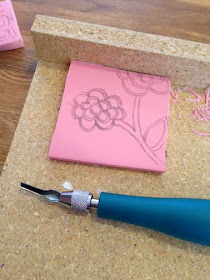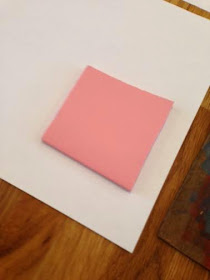Hello friends! Have you ever tried making your own rubber stamps? It's a fun craft and today, I'll show you how.
I learned it at the Brooklyn Brainery where they offer multi-disciplinary topics from crafting to cooking and presentation skills to walking tours of New York City. They promise accessible education at affordable prices.
I had signed up for a stamp making class, otherwise known as block printing. Our teacher was the lovely Jessica Lee Kaufman.
All the materials were provided. This includes a wooden work station, EZ carve (pink rubber printing block), and carving tools.
The carving tool, when unscrewed, opens to reveal an assortment of tips.
Here are the basic rules of block printing:
- Carve away from you (because the carving tips are sharp)
- Shallow dives (use a light hand when carving; the image Jessica gives is a bird gently touching the ocean surface when it takes a drink)
- Fingers behind tool (because again, the tips are sharp)
We first learned how to attach a tip on the carving tool and screw on to tighten (a quick tip: "righty tighty" or turn right to tighten and "lefty loosey" or turn left to loosen). Then we tried our hand at carving by making lines using different tips.
Once we got the hang of it, we were on our way to making our own rubber stamps. I based my design on the flowers from this greeting card. I first made a sketch on paper.
Then I transferred the design to the EZ carve. I flipped the paper (the drawing is now face to face with the EZ carve) and I forcefully shaded the back of the paper with a pencil.
See, the image is now on the EZ carve!
Then I carved the rubber around and inside the design so that in the end, the flowers appear to be raised. Notice that these are very shallow cuts on the surface.
Now it's time to test the stamp. They provided these screen printing inks.
I chose black ink and placed half a spoonful onto a masonite surface. Then I spread the paint using a brayer.
Use the brayer in both directions to get an even coat of paint. If you hear the brayer making a zipper sound, the paint should be ready.
Apply the paint-filled brayer onto the stamp. Make sure to spread this on top of the design with pressure and in different directions.
Test the rubber stamp by flipping it onto a piece of scrap paper. Add some weight with the palm of your hands.
Here's what it looks like.
I'll use it to add a personal touch to blank stationery and blah packages. TADA!
Here are some of my classmates. I think they'll agree, we were pretty pleased with the block prints each of us made!




















No comments:
Post a Comment
Your comments are very much appreciated!